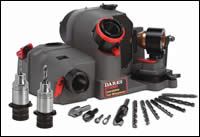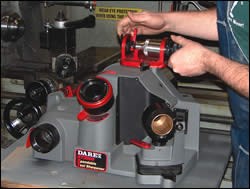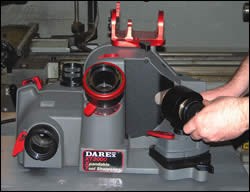Gear Manufacturer Cuts Costs By Reclaiming Used Tools
This gear manufacturer needed to reduce high costs resulting from replacing dull drill bits or sending them out for sharpening. With the XT3000 Xpandable tool sharpener from Darex, the shop has done just that. In addition, the device allows the company to custom-sharpen drills for specific jobs.
Share




Times have changed in the world of manufacturing, says Tim Wood, president of Dalton Gear. “With the current trends and continued demands for tight tolerances that our customers place on us, precision tools are becoming more and more common,” he says.
However, precision tools are expensive, and replacing or sharpening worn tools can further drive up costs.
This was the case at Dalton, where worn drill bits that needed to be either replaced or sent off-site for sharpening significantly reduced profits. To better control its expenses, the shop purchased the XT3000 Xpandable tool sharpener from Darex. Thanks to the device’s high precision, ease of use and ability to custom-sharpen tools to operator specifications, the shop has been able to bring worn drills to like-new condition in-house. Tooling costs are down, and the shop has yet to order new drills since purchasing the device.
Founded more than 50 years ago in Minneapolis, Minnesota, Dalton Gear markets its products in the United States, Canada and Europe. In addition to spur, helical, bevel and worm gears, the company manufactures sprockets, shear-pin couplings, timing-belt pulleys, right-angle gearboxes, drive shafts, transmission shafts and idlers. Manufacturing these components requires various drilling and tapping operations, for which the company’s 35 employees use various CNC machines, mills and drill presses. Materials include mild steels, alloy, brass, bronze, aluminum, stainless steel, cast iron and heat-treated steel. Most of the company’s drills are jobber length, and the most common have a 118-degree point configuration.
According to purchasing manager Scott Holler, Dalton had been experiencing “out-of-control” costs associated with the purchasing and sharpening of drill bits. In fact, a cost analysis revealed that the company had purchased at least $13,000 in new drill bits during a period of several years. After the bits became worn, most sat accumulating dust. Others were sent out for sharpening, if that was economical compared to the cost of buying new tools.
With the XT3000, however, the company has sharpened many of the old drill bits that had accumulated over the years and recovered its initial outlay. “We had about two and a half plastic bins full of dull drills waiting to be sharpened,” Mr. Holler says. “We converted a storage room in our shop just for sharpening drills, with a workbench and shelving bins for the sharpened bits.”
The base XT3000 unit sharpens standard and split-point drill bits at angles ranging from 118 to 150 degrees. It includes two adjustable, stainless steel chucks that accommodate drill bits with diameters ranging from 1/8 inch to 13/16 inch. An optional attachment is available to increase this range to 1 3/16 inches. Lip-height tolerance is 0.001 inch, which exceeds National Aerospace
Standards.
Optional fixtures sharpen other cutting tools such as step drill bits, brad points, 90-degree points, large drill bits and single-flute countersinks. The machine also features left-hand drill capabilities as well as cams for 3- and 6-flute countersinks. All sharpener adjustments and attachment changes are performed without tools. A lock-and-pin system secures the attachments. The device’s solid metal design includes steel and bearing-grade bronze components in all critical places, and roller bearings are incorporated in areas where wear might occur.
The sharpener is available with a choice of CBN Borazon wheels, which are recommended for high speed steel and cobalt tools, or with diamond wheels, which are recommended for carbide cutting tools. These super-abrasive wheels require no dressing, thereby reducing grit. The sharpener is more than 90-percent enclosed and includes a vacuum port that users can connect to a vacuum system to ensure clean operation. It is also available with two different vacuum-powered grit-removal systems. The ¼-horsepower, 3,450-rpm motor is rated for continuous duty.
Rather than tossing dull bits into a basket and pulling newly purchased bits from stock, operators can now sharpen the drills themselves or use re-sharpened bits waiting in reserve. The Darex machine has paid for itself many times over, but the ability to sharpen drills in-house provided Dalton with more than just cost benefits. For example, the company wasn’t always happy with the results of sending tools out of the shop for sharpening. With the XT3000, however, it can better ensure a quality job. According to Dalton Gear staff, the re-sharpened drill bits are on-size and work as well as new ones.
Operators also like the fact that the sharpener is easy to use—most people in the shop intuitively understand how to operate it. Users can often begin sharpening bits after only a brief demonstration. In addition, the sharpener allows Dalton personnel to control each drill-bit point configuration, including the relief and design of the split point. For example, an ordinary jobber drill can be re-sharpened into a high-performance split drill.
“In these tight economic times, this machine has helped us control expenses by sharpening drills in-house rather than sending them out for sharpening or buying new,” Mr. Holler says. “These types of expenses come out of the profit of what we are selling. The value of the Darex machine is that it allows profits to stay where they need to be.”
Related Content
Finding the Right Tools for a Turning Shop
Xcelicut is a startup shop that has grown thanks to the right machines, cutting tools, grants and other resources.
Read MoreHigh-Feed Machining Dominates Cutting Tool Event
At its New Product Rollout, Ingersoll showcased a number of options for high-feed machining, demonstrating the strategy’s growing footprint in the industry.
Read MoreHow to Mitigate Chatter to Boost Machining Rates
There are usually better solutions to chatter than just reducing the feed rate. Through vibration analysis, the chatter problem can be solved, enabling much higher metal removal rates, better quality and longer tool life.
Read MoreBriquetting Manufacturer Tools Up for Faster Turnaround Times
To cut out laborious manual processes like hand-grinding, this briquette manufacturer revamped its machining and cutting tool arsenal for faster production.
Read MoreRead Next
Registration Now Open for the Precision Machining Technology Show (PMTS) 2025
The precision machining industry’s premier event returns to Cleveland, OH, April 1-3.
Read MoreSetting Up the Building Blocks for a Digital Factory
Woodward Inc. spent over a year developing an API to connect machines to its digital factory. Caron Engineering’s MiConnect has cut most of this process while also granting the shop greater access to machine information.
Read More5 Rules of Thumb for Buying CNC Machine Tools
Use these tips to carefully plan your machine tool purchases and to avoid regretting your decision later.
Read More


























.png;maxWidth=300;quality=90)










